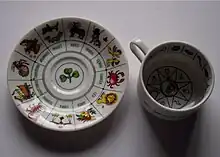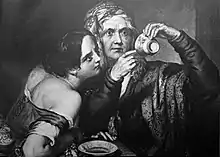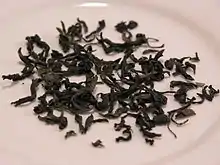Tasseography
Tasseography (also known as tasseomancy, tassology, or tasseology) is a divination or fortune-telling method that interprets patterns in tea leaves, coffee grounds, or wine sediments.

The terms derive from the French word tasse (cup), which in turn derives from the Arabic loan-word into French tassa, and the respective Greek suffixes -graph (writing), -mancy (divination), and -logy (study of).
History

Tasseomancy followed the trade routes of tea and coffee and was practiced by both Baltic and Slavic nations. It is closely related to the Romani people, whose nomadic lifestyle contributed to the spread of the practice, though its exact origins are unknown. Throughout its history, different regions have practiced it with slight variations which indicates that this form of divination was an oral tradition. It is not considered a closed cultural practice, but oftentimes it is traditional to ask permission from a Romani elder as a sign of respect. [1]
Western tasseography can be linked to medieval European fortune tellers who developed their readings from splatters of wax, lead, and other molten substances,[2] which are related to many similar and established rituals in Asia such as pagtatawas.[3]
According to different sources, coffee fortune-telling first appeared in the Ottoman Palaces in the 1500s. Arabic coffee is a coffee culture that later spread from Yemen to the rest of the Middle East, Ottoman Empire and the Balkans, and then to many parts of the world. Coffee started somewhere in the Arab world and West Asia. When they were bored, the concubines in the Ottoman harem used to drink coffee and tell each other fortunes to chat and gossip.[4]
Method of tea-leaf reading
The Encyclopedia of Occultism & Parapsychology, Fifth Edition, Vol. 2, edited by J. Gordon Melton, notes:
After a cup of tea has been poured, without using a tea strainer, the tea is drunk or poured away. The cup should then be shaken well and any remaining liquid drained off in the saucer. The diviner now looks at the pattern of tea leaves in the cup and allows the imagination to play around [with] the shapes suggested by them. They might look like a letter, a heart shape, or a ring. These shapes are then interpreted intuitively or by means of a fairly standard system of symbolism, such as: snake (enmity or falsehood), spade (good fortune through industry), mountain (journey of hindrance), or house (change, success).
Melton's described methods of pouring away the tea and shaking the cup are rarely seen; most readers ask the querent to drink the tea off, then swirl the cup.
Regarding interpretation of leaves, according to James Randi, "Leaves on the bottom, we're told, indicate the distant future, those on the rim the immediate future. Tea leaf stems represent persons. Fat stems are fat people, for example."[5]
Fortune telling tea cups

Although many people prefer a simple white cup for tea leaf reading, there are also traditions concerning the positional placement of the leaves in the cup, and some find it easier to work with marked cups. Beginning in the late 19th century and continuing to the present, English and American potteries have produced specially decorated cup and saucer sets for the use of tea-leaf readers. Many of these designs are patented and come with instructions explaining their mode of use. Some of the most common were those that were given away with purchases of bulk tea.
Coffee reading

Coffee reading (Arabic: قراءة الفنجان, romanized: qirāʾat al-finjān; Persian: فال قهوه; Turkish: kahve falı; Greek: καφεμαντεία; Serbian: гледање у шољу) is traditionally practiced using Arabic or Turkish coffee, as they produce a very thick sediment. The coffee in the cup is consumed, and the sediment is left to settle.
There are several variations of coffee reading. They commonly require for the cup to be covered with the saucer and turned upside-down. In the Turkish tradition, coffee-readers often interpret the cup as being divided into horizontal halves: symbols appearing on the bottom half are interpreted as messages regarding the past, and symbols on the top half are messages regarding the future. The cup may also be interpreted in vertical halves to determine "yes" or "no" answers as well as the overall outcome of the events represented by symbols. For example, some fortune tellers may "read" symbols in the "left" half as "negative" events or outcomes, while symbols in the "right" half are "read" as "positive". Other readers may adhere to the belief that the cup is capable of revealing insights about the past, but it cannot predict events beyond forty days into the future. The saucer may also be incorporated into the reading. As with the cup, different variations exist for what the saucer represents, including whether the saucer sticking to the cup indicates a "positive" or "negative" outcome.[6]
Symbols
When a cup of tea or coffee has been drunk, a sediment often remains.
This sediment can be known to form patterns or symbols within it, leaving a perfect canvas for interpretation. There are many possibilities of images appearing in a cup.[7] Images formed in a cup are created and uniquely seen by the reader, so it is often said that the only limitation for cup reading is the imagination of the reader themselves.[8]
Symbols can be many things, including physical objects and abstract concepts. Often, the reader will interpret symbols together for a prediction as well as acknowledging their individual meanings.[7]
Symbol interpretation can be drawn from history, statistics, pop culture references, and often nature or how we interact with the world.[1] There are also many classic image interpretations that were developed in Great Britain in the late 1800s as tasseomancy gained popularity as a parlour game.[7]
In popular culture
- Qari'at al-Finjan (قارئة الفنجان), a classic Arabic song
- In the Harry Potter books written by J. K. Rowling, the divination teacher Sybill Trelawney practices tasseography with tea leaves
See also
- Methods of divination
- Pareidolia – Perception of meaningful patterns or images in random or vague stimuli
- Rorschach test – Psychological test created in 1921
Notes
- O'Reilly, Annie (2014). Tea with Annie, a divinitive guide to Tasseomancy and its artistry. Melbourne, Australia: Whiteslaw Press.
- Guiley, Rosemary. "tasseomancy." The encyclopedia of witches, witchcraft, and wicca. 3rd ed. N.p.: Infobase Publishing, 2008. 341. Print.
- International Journal of Medical Students. Folk Medicine in the Philippines: A Phenomenological Study of Health-Seeking Individuals. 2021.
- "Turkish Coffee Fortune-Telling - Meaning of Figures and Symbols". Discover all about Turkish People & Turkey!. 2022-03-04. Retrieved 2022-03-23.
- Randi, James (1995). An encyclopedia of claims, frauds, and hoaxes of the occult and supernatural: decidedly sceptical definitions of alternative realities. New York, NY: St. Martin's Griffin. ISBN 978-0-312-15119-5.
- "Your Future in a Cup of Coffee". Turkish Cultural Foundation. 2011. Web.
- "Tea with Annie". Retrieved 2020-03-05.
- O'Reilly, Roxy (2009). The Lady of the Cup. Perth, WA: Quality Press. p. 9. ISBN 9780980376012.
References
- Fenton, Sasha Tea Cup Reading: A Quick and Easy Guide to Tasseography. Red Wheel / Weiser, 2002
- Fontana, Marjorie A. Cup of Fortune: A Guide to Tea Leaf Reading. Wis.: Fantastic, 1979.
- Kent, Cicely. Telling Fortunes By Tea Leaves. 1922
- Posey, Sandra Mizumoto. Cafe Nation: Coffee Folklore, Magick, and Divination. Santa Monica: Santa Monica Press, 2000.
- Sheridan, Jo. Teacup Fortune-telling. London: Mayflower, 1978
- Yaman, Beytullah. The Art of Turkish Coffee Brewing. Ankara: Bilkent University Press, 1987
- O'Reilly, Annie. Tea with Annie, a divinitive guide to Tasseomancy and its artistry. Melbourne: Whiteslaw Press, 2014.
- O'Reilly, Roxy. The Lady of the Cup. Perth, Quality Press, 2009.
External links
- Tea-Cup Fortune Telling at Faded Page (Canada)
- Tea-Cup Reading, and the Art of Fortune-Telling by Tea Leaves, by 'A Highland Seer', from Project Gutenberg
